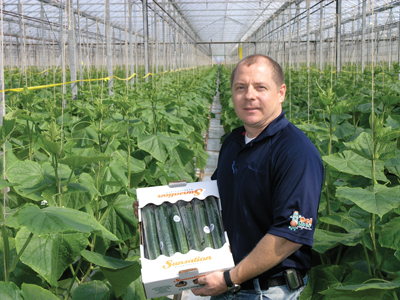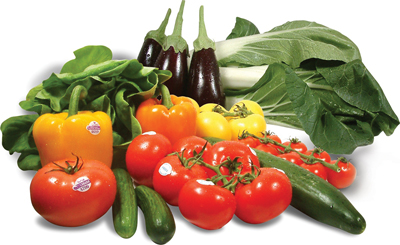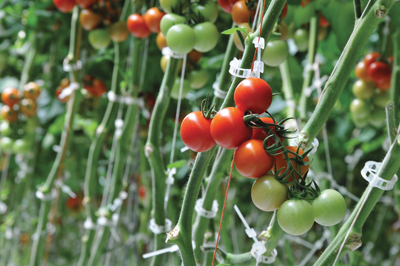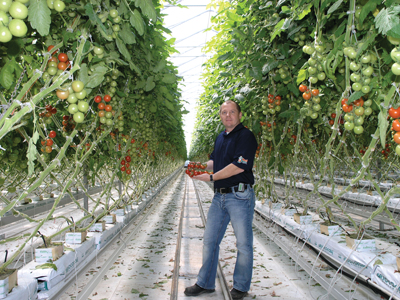
If variety is indeed the spice of life, Sunsation Acres is an especially well-seasoned operation.
The 16-acre greenhouse vegetable operation is located in Kingsville, Ontario. The product mix is quite diversified
If variety is indeed the spice of life, Sunsation Acres is an especially well-seasoned operation.
The 16-acre greenhouse vegetable operation is located in Kingsville, Ontario. The product mix is quite diversified and includes:
- 7.5 acres of long English cucumbers.
- 5.5 acres of beefsteak tomatoes.
- 2.5 acres of mini-cucumbers.
- A half-acre of cocktail tomatoes.
 |
|
| Jim Slater, in a young cucumber crop.
|
It has underground water treatment facilities in its original greenhouses, and above-ground units in the newer facilities. Its greenhouses range from six to seven metres in height. It has a traditional natural gas boiler system, and a new fluidized bed technology unit that can burn a number of fuels, including natural gas.
Sunsation co-owners Jim Slater and his twin brother Mark are also connected to field vegetables through Erie James Ltd., their vegetable wholesaling company that markets an extensive catalogue of field and greenhouse crops throughout North America. They bought Erie James from their dad, Don, in 1996.
 |
|
| A sampling of Erie James Ltd. produce;
|
ERIE JAMES ONE OF ONTARIO’S FOUNDING PRODUCE MARKETERS
Erie James was one of the founding produce marketing companies in the province, and continues to work with a number of leading growers in the region.
Jim looks after Sunsation, while Mark handles Erie James.
For Jim, no two days in the greenhouse are ever the same. And he likes it that way. “You’re never doing the same thing every day.” he jokes. “You have to wear a number of hats to be successful.”
As busy as the farm keeps him, he also devotes time as vice-chair of District One of the Ontario Greenhouse Vegetable Growers association. This district covers Essex and Kent counties, the largest concentration of greenhouse vegetable production in North America.
It’s great to get involved “and help steer the industry,” he notes. He has served on the board since 2005.
OGVG is widely regarded as one of the most progressive farm organizations in North America, particularly with its work on food safety. They were the first group of growers on the continent to regulate food safety in their industry. Yearly, third-party food safety audits are required, and a traceability requirement has been added.
AWARD FOR AGRI-FOOD EXCELLENCE REFLECTS OGVG’S FOOD SAFETY PROGRAM
Last year, Sunsation Acres received one of 55 Premier’s Awards for Agri-Food Excellence. The award reflected the OGVG’s food safety program, says Jim. OGVG nominated Sunsation for the award. “We received the award on behalf of the industry.”
 |
|
| A closeup of one of the Sunsation crops.
|
While Erie James has very long industry roots, going back to the 1920s, Sunsation Acres is a relative industry newcomer.
The first five acres were built in 1998 to grow beefsteak tomatoes. They expanded to 10 acres in 2004 and switched to English cucumbers and mini-cucumbers. In 2007, six acres were added and the current crop mix has evolved since then.
The variety of crops can be challenging. “Tomatoes and cucumbers are completely different crops,” says Jim, “with different climate and nutrient management requirements, different biological control programs, and different pests and diseases.”
In addition to constant monitoring by its own staff, Sunsation also has professional scouts checking things out each week. “Our crops are on a full biological IPM (Integrated Pest Management) program; we’re combating bad bugs by introducing good bugs. The key to avoiding problems is to be proactive, to catch problems at an early stage and deal with them.”
CONSIDERABLE ATTENTION TO NEW VARIETY TRIALLING
Sunsation also devotes considerable attention to new variety trialling. They’re looking for varieties that not only have better yields, but better taste and overall quality, and that feature sizing suitable for the increasingly popular direct-to-consumer packs.
Jim feels the industry still has many growth opportunities. It has a tradition of “opening new doors.”
The specialty segment in general is definitely growing, though he says Sunsation has no plans at present to increase its cocktail tomato crop. “There’s significant production from what we already have.”
 |
|
| Jim Slater, in one of the tomato greenhouses.
|
Mini-cucumbers are getting a lot of attention, and new export markets are opening. For consumers, the minis haven’t displaced long English cukes on the weekly grocery list; consumers are buying both. “They’re especially kid-friendly,” says Jim. Because of their convenience, they have a role to play in the movement to get people eating healthier.
The period of the late 1980s and 1990s was a time of considerable growth, with great demand for greenhouse products throughout North America. Canadian growers back then were assisted by a much lower dollar with their exports. That’s all changed, and it will be a major challenge for Canadian growers for some time. “The harmonized dollar is one of the major challenges we face today. About 65 to 70 per cent of production in Ontario is exported.”
Another challenge is the increase in the minimum wage, which will come “right off the bottom line. This is a non-recoverable cost and it has a huge impact on Ontario farming.”
‘MOST GREENHOUSES ARE RUNNING QUITE LEAN AS IT IS.’
There’s very little in the way of possible cost-cutting. “Most greenhouses are running quite lean as it is.”
The price of natural gas has receded over the past year or so, and that’s been a big help. “We’d always like it to be lower,” quips Jim. As for the future, “we’d be naïve to think it’s going to stay there.”
Sunsation’s alternative fuel boiler will come in handy should gas prices spike. Also being considered is a solar energy project, primarily for the electricity market, along with the installation of energy curtains.
“The most challenging thing about being a grower today is everything we can’t control,” Jim explains. “Even though we grow indoors, we still have to have Mother Nature smiling on us.” ■
Print this page